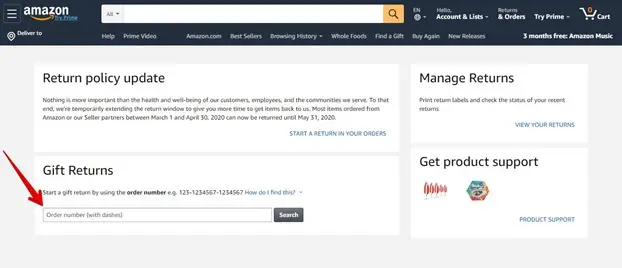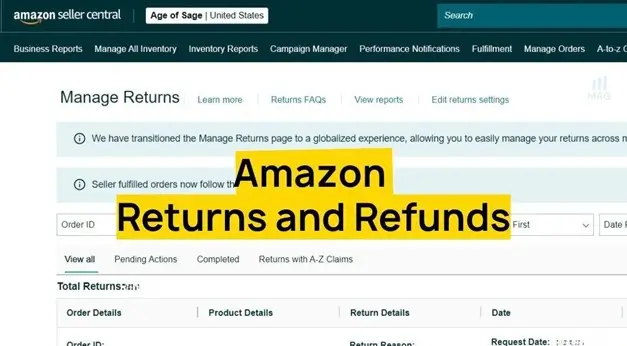HOW CAN AMAZON SELLERS DEAL WITH RETURNS IN 2024?
In 2024, Amazon merchants that work with an Amazon Wholesale Agency can simplify returns. Sellers can effectively handle the procedures of restocking, resale, and return logistics by utilizing their experience. Through this partnership, returns are handled smoothly, improving customer happiness and maximizing inventory management tactics on the Amazon platform.
Amazon selling has the potential to be both lucrative and difficult. There is no denying the
excitement of expanding your company on the biggest online marketplace in the world, but there are certain things that call for cautious thought and a calculated strategy. One such area that frequently proves to be difficult is handling Amazon’s return guidelines, refund procedures, and the somewhat complicated world of customer service. We hope to clarify these important facets of the Amazon seller journey in this blog. In addition to explaining the nuances of Amazon’s return guidelines and refund processes, our Amazon consulting specialists will look at efficient methods for managing returned goods and customer interactions.
Following Amazon's return guidelines

Amazon FBA (Fulfillment by Amazon) and FBM (Fulfillment by Merchant) vendors, Amazon has different return policies. Amazon handles all aspects of the returns process for FBA sellers, including providing return labels, inspecting the items, and restocking. This makes Amazon’s effective return management system available to Amazon FBA sellers. FBM merchants, on the other hand, have better control over product conditions and may be able to charge restocking fees for damaged products because they handle the receiving and refilling of returns.
FBM vendors on Amazon must adhere to or beyond the company’s regular return policy, which states that returns must be accepted within 30 days. Amazon often issues refunds to customers quickly—often even before the vendor has the returned item. The Refund at First Scan (RFS) policy of Amazon is to blame for this. Yet FBM vendors have the choice for the automated return shipping labels offered by the Amazon Prepaid Returns Label program
- Returns for opened products: Regardless of whether an item was opened or not, buyers can usually return opened items to Amazon within the allotted 30-day return window. There are several exclusions for customized or perishable goods.
- Returning used goods: Consumers can return used goods by filling out a return request
form, although there may be more stringent policies in place for some product
categories, such as health and personal care. Sellers ought to explain their return
guidelines. - Tax processing for Amazon returns is handled by Amazon, which includes figuring out,
getting, and returning any relevant taxes and regulatory fees.
How can vendors on Amazon effectively manage returns?

1: Document all returns.
For Amazon sellers and specialists in Amazon seller account administration, keeping track of the return notice email from Amazon is essential to effective return handling. When a consumer emails a seller to request a return, this email acts as their first point of contact. This is a thorough paragraph that explains its importance:
An essential document in an Amazon seller’s return handling procedure is the email they send out indicating a return. It provides crucial details regarding the customer’s request, such as the order number, the reason for the return, and the item being returned, and it initiates the return trip. Sellers who carefully archive and preserve this email not only make sure they have a copy of the customer’s intent, but they also have a useful point of reference for monitoring the status of the return. This record becomes particularly crucial when handling many returns or potential dispute situations. Sellers can review this notification at any time to confirm the specifics of the return and guarantee a precise and seamless settlement. It also acts as a financial reconciliation audit trail, assisting Sellers conduct their business with accountability and openness. As the cornerstone of effective return management, the return notification email enables merchants to promptly and accurately respond to inquiries from customers, thereby improving the entire customer experience on the Amazon platform.
To successfully resolve underlying issues and lower future return rates, Amazon sellers must have a thorough understanding of the causes behind product returns.
2: Determine the cause of returns.
To successfully resolve underlying issues and lower future return rates, Amazon sellers must have a thorough understanding of the causes behind product returns. Here’s more information on determining the causes of returns and the significance of this procedure:
- Quality and flaws: Sellers are required to look into returned goods that have flaws or
quality problems. In order to resolve the underlying source of the issue, this may include
getting in touch with the manufacturer or supplier. Sellers can avoid future returns
resulting from similar concerns by addressing quality issues. - Delivery delays: Sellers should evaluate their shipping and logistics procedures if
delivery delays consistently result in returns. For customers to be satisfied, delivery must
be trustworthy and on time. Refunds for delayed delivery can be reduced by taking care
of shipping-related problems. - Customer feedback: You may learn a lot about the reasons behind customers’ return
actions by getting in touch with those who do so. Direct contact like this can reveal
details about specific problems that return reason codes alone might not be able to
reveal. By interacting with consumers, vendors may resolve issues and even win back
clients who might not otherwise return.
Amazon provides vendors with a reporting tool to examine return information. In their Seller Account, sellers may go to “Reports,” “Fulfillment,” “Customer concessions,” and finally “Returns” to generate a report. This report helps sellers uncover reoccurring difficulties by giving a thorough overview of return causes and patterns.
3: Examine the returns
For Amazon sellers that use Fulfillment by Amazon (FBA) or Fulfillment by Merchant (FBM), inspecting returns is an essential procedure. There are two main goals this procedure accomplishes:
1. Suitability for resale:
Vendors must assess returned goods to see if they are in a state that permits resale. This includes evaluating the product’s completeness, quality, and packaging. It is extremely important for FBM vendors to make sure that returned goods live up to the high standards that Amazon customers demand. An item can re-enter the inventory and minimize possible losses if it can be marketed as new or reconditioned.
2. Correctness of return reason:
Vendors must also confirm if the claimed reason for return corresponds with the item’s true condition. Customers occasionally choose return reasons that are eligible for free return postage, such as saying an item is damaged when it isn’t. This may have a detrimental effect on an Amazon seller’s metrics. Therefore, it’s crucial to verify that the return reason is accurate.
It is advisable for a seller to take action if, upon investigation, it is found that a returned item is not genuinely faulty but was designated as such by the client. Here is a suggested course of action:
Regarding FBM vendors:
- Send Amazon a support ticket.
- Give photographic proof of the item’s true state to prove it is in good working order.
- Add the order sheet or any other pertinent paperwork.
- The seller may receive payment as a result of this correspondence, which would lessen
any possible loss brought on by the false return reason.
Regarding FBA vendors:
- For FBA sellers, inspecting returns from Amazon is a little more complicated.
- For standard-sized products, there may be a 50 cent fee associated with getting a
removal order for the returned item. - After that, the item can be evaluated and put back into inventory if it is determined to be in resalable condition.
4: Keep an eye on return patterns
For Amazon sellers, tracking return patterns is a useful habit since it gives them insight into the causes of consumer returns. Sellers and Amazon seller specialists may make well-informed judgments to enhance their listings and items by closely monitoring these patterns. Here’s more information on the importance of tracking return trends and how it might help sellers:
1. Recognizing trends:
Vendors can spot recurring patterns by routinely going over and examining the causes of returns. Sellers are able to monitor frequent problems or worries, including differences in product quality, size, or description, that result in returns. The first step in resolving the underlying causes of returns is identifying these patterns.
2. Well-informed decision-making:
Sellers can reduce future returns by making well-informed decisions armed with information on return patterns. For instance, merchants should update their size charts, give more precise product descriptions, or think about providing more sizing alternatives if a particular size-related problem results in a lot of returns. Long-term returns may be decreased by these choices.
3. Product enhancements:
Return trend analysis might point up areas in which a product needs to be improved. Sellers might work with suppliers to find solutions to ongoing problems, improve quality control procedures, or improve product designs based on feedback from returning customers. Reduced returns and increased customer satisfaction are possible outcomes of these enhancements.
4. Listing updates:
Listing updates might also be influenced by return trends. To better meet consumer expectations, sellers might add more photos, update product descriptions, or provide
clarifications to product specs. Sellers can lessen the possibility of product returns because of miscommunication by appropriately characterizing their offerings.
5: Handle your refunds.
Amazon offers a number of solutions to assist sellers in effectively managing returned or
damaged goods and reducing possible losses. With the help of these initiatives, merchants may donate to charitable organizations or recover some of their inventory costs instead of having to return or discard it. An extended description of these programs may be found here:
1. Liquidations by FBA:
Instead of paying extra storage costs or having the goods destroyed, the FBA Liquidations
program is meant to help sellers get rid of surplus inventory and customer returns. This is how it operates:
Seller Central is where sellers may make a request for liquidation.
Amazon assesses a number of variables to calculate the product’s average selling price.
- This inventory is usually bought by wholesale liquidators for five to ten percent of the
average selling price of the product. - Within sixty days of a liquidator purchasing the goods, Amazon pays the seller.
- With the help of this initiative, merchants may recoup part of the value from their surplus
or old inventory, saving them money instead of having to reimburse Amazon for returns
or damaged goods.
2. FBA Approve and Remarket:
Instead of paying to return or destroy unfulfillable returned goods, sellers can relist and sell it as used through the FBA Grade and Resell program. The procedure entails the following steps:
- Vendors enroll their unsold merchandise in the service.
- After assessing the products’ condition, Amazon rates them as Used-Like-New,
Used-Very Good, Used-Good, or Used-Acceptable. - These rated products get fresh listings on Amazon.
- This approach minimizes waste and its negative effects on the environment, while also
assisting sellers in recovering possible losses from returned goods.
3. Donations from FBA:
Instead of throwing out or returning qualified goods, sellers have the choice to give it to specific US charity through the FBA Donations program. The following are this program’s main points:
- Sellers may use Amazon’s FBA Donations service to donate extra or unusable goods.
- Amazon is distributing donated merchandise to a network of US NGOs through a
partnership with the nonprofit Good360. - By giving things a new purpose and supporting people in need, this initiative decreases
waste. - Additionally, it can provide sellers with possible tax advantages for their charitable
donations. - FBA Donations offer an environmentally beneficial substitute for getting rid of unsold
goods, supporting charity organizations as well as environmental sustainability.
4. Listing updates:
Listing updates might also be influenced by return trends. To better meet consumer expectations, sellers might add more photos, update product descriptions, or provide
clarifications to product specs. Sellers can lessen the possibility of product returns because of miscommunication by appropriately characterizing their offerings.
Concluding the discussion
It’s true that receiving returns is a necessary part of running a business. The secret to success, though, is to effectively minimize and manage them. Sellers may lower return rates and raise customer satisfaction by emphasizing the quality of their products and carefully optimizing their listings with lots of information.
In the end, effectively managing returns is more than simply a procedure; it’s a calculated
method that supports the overarching objective of creating a successful and respectable
Amazon or e-commerce company. The Amazon consultants at Manisofts are here to help if you need professional advice on accomplishing this objective. They can provide you with customized methods and solutions to help you deal with the complexities of return management and advance your company’s growth and success




